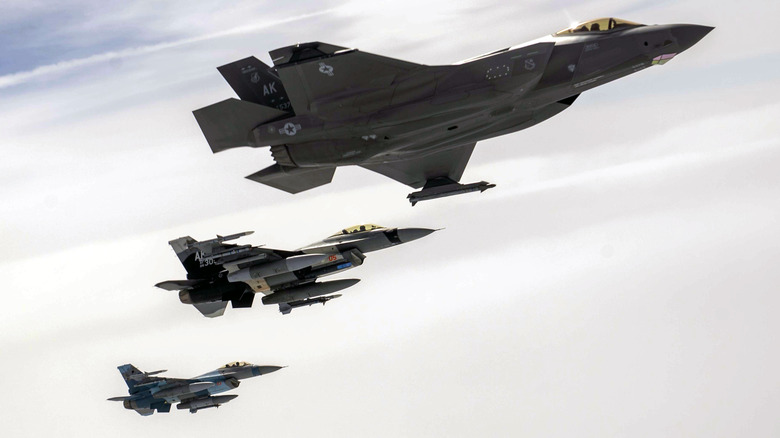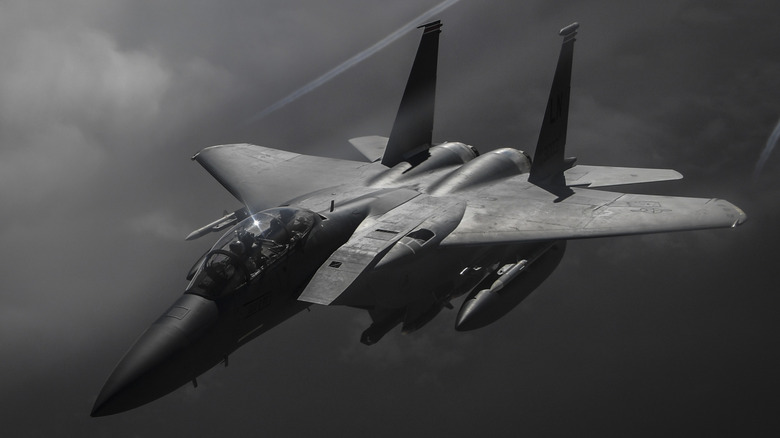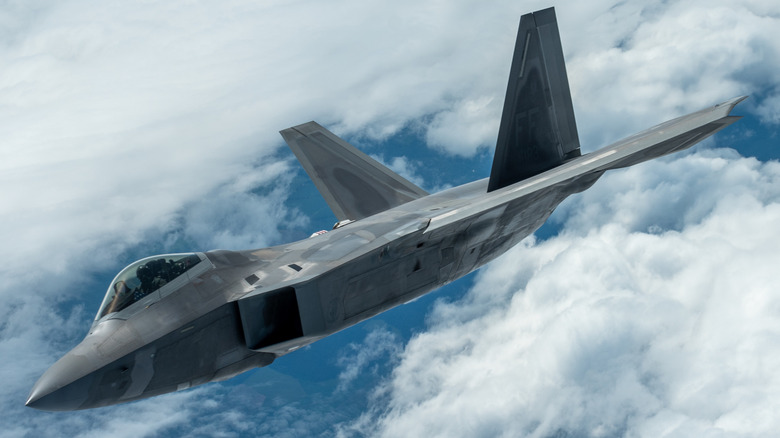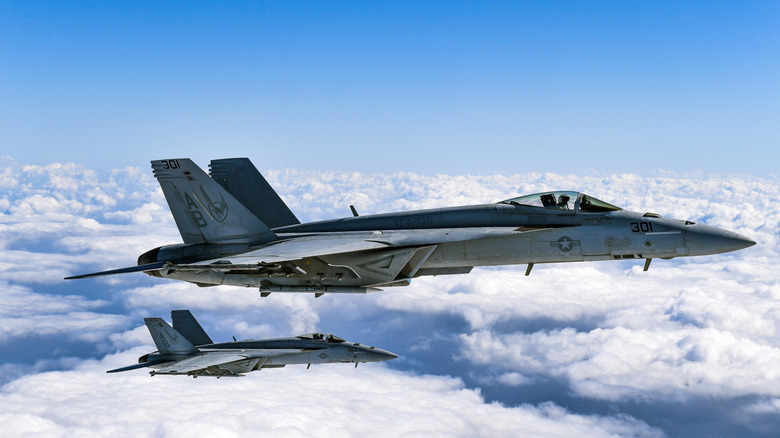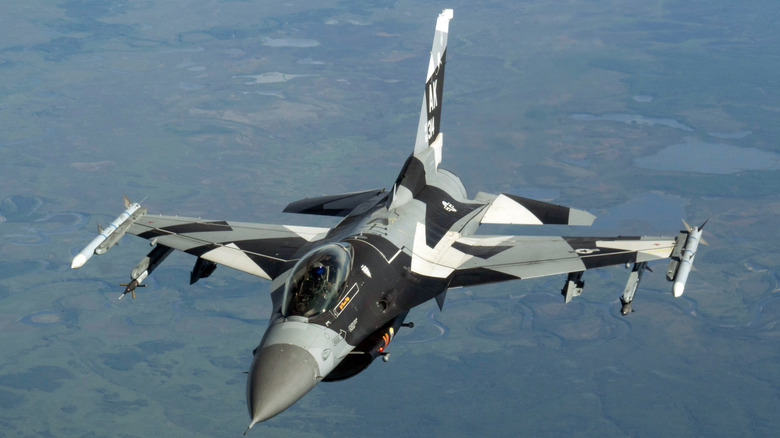5 Of The Fastest US Fighter Jets In Service Today
As is to be expected, the United States military has a wide range of aircraft at its disposal. From slow propeller-powered trainers like the T-6 Texan II to giants like the B-52 Stratofortress, a nuclear-capable bomber that's been flying since the 1950s. It's a diverse fleet that meets diverse needs. However, it's when we look at its jet fighters that we really get amongst the thoroughbreds. Sleek, fast, and commonly stealthy nowadays, these are aircraft that are designed to operate on the very limits of engineering know-how.
While raw speed isn't the only metric that makes a fighter jet a fearsome weapon, it's certainly one of the main ones and definitely among the most exciting. Many of today's fighters can screech through the sky at more than twice the speed of sound, and do so while carrying smart weapons, advanced sensors, and advanced systems that their predecessors could only dream of.
It isn't just the latest generation of jets that boast impressive speeds. Some golden oldies are still holding their own, proving that speed never truly goes out of style. Let's have a look at some of the fastest US jet fighters in service today.
F-15E Strike Eagle - A bird of prey
When looking at America's fastest jet fighters, there is no better place to begin than with the F-15E Strike Eagle. The first-ever flight of an F-15 variant was made in July 1972, with the F-15E variant first taking to the skies in April 1988. Powered by two Pratt & Whitney F100-PW-229 or 220 turbofan engines with afterburners, the fighter can reach a blistering top speed of 1,875 mph (over Mach 2.5) and was also the first U.S. fighter jet to be able to accelerate even when while in a vertical climb.
With the F-15E approaching 40 years of service, it's fair to say that this is an aging aircraft — one that lacks the stealth features of 5th-gen fighters. However, rather than retire gracefully and let the next generation take its place at the top of the table, a set of upgrades has given the F-15E a new lease on life. The increased use of drones on the battlefield has seen the F-15E repurposed as a drone hunter.
They say you can't keep a good plane down and the F-15 is certainly that. When talking about the jet fighter, F-15E pilot Lt. Col. Tyler Cox, said, "Its got 104 air-to-air kills and it's never been shot down in combat," according to the Air National Guard. It's a fitting testament to this jet that the pilots who fly it call it the world's greatest air superiority fighter.
F-22 Raptor - Definitely not a dinosaur
Moving forward a generation, we come to the 5th-gen sleekness of the F-22 Raptor. Rated as a Mach two class with "supercruise" capability, the F-22 Raptor can reach speeds of 1,498 mph or Mach 2.25 at higher altitudes. When it comes to speed, the F-22's supercruise ability is worth discussing. This uses a combination of sleek aerodynamics and powerful engines that allow the Raptor to cruise at speeds of over Mach 1.5 without firing up those fuel-guzzling afterburners.
The engines in question are two Pratt & Whitney F119-PW-100 turbofans with afterburners and two-dimensional thrust vectoring nozzles that can produce a staggering 35,000 lbs of thrust each. The engines are designed in such a way that crews can perform standard maintenance procedures using just six tools available from your typical hardware store.
Despite entering service over twenty years ago, there are still many classified details about the fighter. The general public getting a peek inside the advanced cockpit of the F-22 Raptor only recently became a possibility. As a testament to this plane, it's worth remembering that despite its age, it remains the stealthiest jet fighter ever built – and still one of America's fastest jet fighters.
F/A-18E/F Super Hornet - Comes with a sting
Despite having a numerical designation that looks like it was plucked from a bowl of alphabet soup, the F/A-18E/F Super Hornet — or simply Super Hornet — is the U.S. Navy's seasoned fighter jet. It doesn't quite hit Mach 2 like some of its Air Force counterparts, but the Super Hornet still boasts an impressive top speed of 1.8 Mach or 1,381 mph. The Navy adopted it in 1999 as a replacement for the legendary Top Gun fighter the Grumman F-14 Tomcat. However, it was with the introduction of the Block II Super Hornet in 2001, featuring new capability-enhancing technologies, that the plane really began to soar.
Since then the Super Hornet has gained a well-earned reputation as the workhorse and backbone of the Navy's carrier-borne fleet and is considered its most advanced multi-role strike fighter. Among the many munitions the Super Hornet can wield are the AIM 9 Sidewinder, Harpoon, Maverick, and Harm missiles. Additionally, it also supports the Joint Stand-Off Weapon (JSOW) and Joint Direct Attack Munition (JDAM) weapon systems.
Powered by two F414-GE-400 turbofan engines, producing 22,000 pounds of thrust each, the Super Hornet has a range of 1,467 miles and a maximum ceiling of over 50,000 feet. That's not a bad series of specifications for a fighter that's been around since Bill Clinton was in the White House.
F-35A Lightning II - A force of nature
The latest addition to the USAF's fighter arsenal is the fifth-generation F-35A Lightning II. It may not be the fastest on the list — the F-35 Lightning II earned its name not because it's as fast as lightning — but it is a force of nature. However, this doesn't mean we're calling the F-35 a slouch, far from it. Despite being designed with the compromises required to make a plane stealthy, the F-35 lightning still boasts a top-line speed of Mach 1.6 or 1,200 mph. This is even more impressive when you consider that this is a single-engine fighter.
Powering the Lightning II is a Pratt & Whitney F135-PW-100 turbofan jet engine, producing a mind-boggling 43,000 pounds of thrust. Development of this plane was very much an international affair with nine countries involved including the U.S., U.K., Canada, Italy, and Australia. The program's goal was to create a versatile and stealthy plane bristling with next-generation technologies that were capable of replacing the existing and aging fleet of tactical aircraft.
Among the planes the F-35 was designed to replace are the A-10 Warthog, the U.S. Navy's F/A-18s, and the U.K.'s Harrier GR.7s and Sea Harriers. A list of planes that demonstrates just why the F-35 Lightning is considered more than just a plane — but a force of nature.
F-16C Fighting Falcon - Still flying high
We began our list with a fighter named after a bird of prey, so, it seems fitting that we finish it with another fighter named after a bird of prey — the F-16C Fighting Falcon. Despite being a design that dates from the early-seventies, the continued evolution of the F-16 means it's still the most numerous fighter in the USAF's arsenal. As of September 2021, there were 1,017 F-16 C and D variants listed in the USAF inventory. The Falcon is a relatively low-cost, multi-role fighter that punches above its price-point when it comes to performance.
Depending on the variant, powering it to a top speed of 1,500 mph (Mach 2) is a single GE F110-GE100/129 or a Pratt & Whitney power plant including the F100-PW-200 turbofan. Each engine produces about 27,000 pounds of thrust. This isn't a fighter that needs to beg for a place in the USAF's Hall of Fame. It boasts a list of merits that ensures its legacy as one of the most successful combat aircraft ever built. With more than a thousand still in service with the USAF and many more in use around the world, the F-16 continues to serve as a frontline fighter across multiple air forces.
Its frameless bubble canopy offers superior visibility, its fly-by-wire controls allow for precise handling, and its agility — especially in dogfights — has made it a legend. After all, there aren't many 50-year-old fighters that can still boast relevance on modern battlefields.
